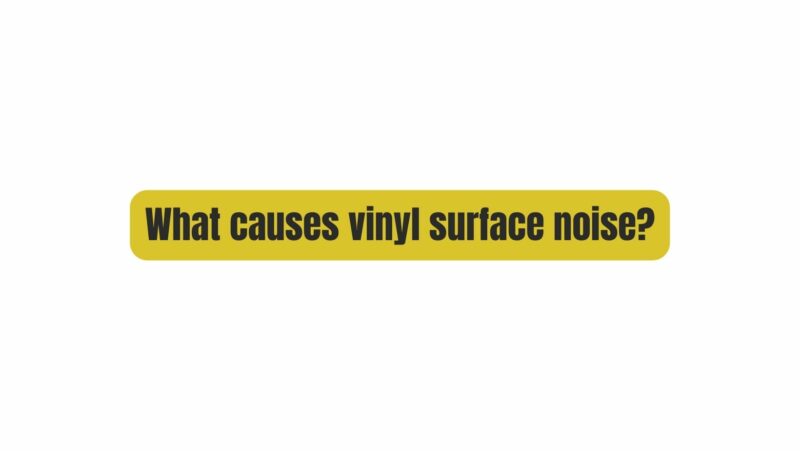Vinyl records have enjoyed a remarkable resurgence in recent years, captivating music enthusiasts with their warm, analog sound. Despite the advent of digital music formats, many still consider vinyl to be the gold standard for audio quality. However, one persistent issue that vinyl aficionados often grapple with is surface noise. The pops, crackles, and hisses that can plague vinyl playback can be distracting and frustrating. In this article, we will dive deep into the world of vinyl surface noise, exploring the various factors that cause it and offering insights into how you can mitigate these unwanted sounds for a more pristine listening experience.
- The Anatomy of a Vinyl Record
To understand vinyl surface noise better, it’s essential to grasp the structure of a vinyl record. Vinyl records store music in analog form, with audio waveforms physically etched into grooves on the surface. When a stylus (needle) is placed on the record, it follows these grooves, translating the physical movements into sound waves. However, this intricate process is susceptible to a range of factors that can introduce noise.
- Dust and Dirt
One of the most common culprits for vinyl surface noise is dust and dirt. Vinyl records are like magnets for these tiny particles. Even a seemingly clean record can accumulate microscopic dust in the grooves. When the stylus passes over these particles, it can produce pops and crackles in the audio signal. Regularly cleaning your records and stylus is crucial for mitigating this issue.
- Wear and Tear
Vinyl records are not indestructible. Every time you play a record, the stylus exerts pressure on the grooves, causing microscopic wear and tear. Over time, this wear accumulates, leading to increased noise and diminished sound quality. Proper storage and careful handling of your vinyl records, along with investing in a high-quality turntable, can help minimize wear and tear.
- Record Quality
The quality of the vinyl record itself can significantly impact its susceptibility to surface noise. Cheaper or poorly manufactured records may have more imperfections, including small bumps or irregularities in the groove. These imperfections can lead to increased noise during playback. Investing in well-pressed records from reputable labels can help mitigate this issue.
- Static Electricity
Static electricity is another frequent source of vinyl surface noise. When you handle a record, static electricity can build up on the surface. This static can attract dust and cause pops and crackles during playback. Anti-static brushes and mats, as well as maintaining proper humidity levels in your listening environment, can help reduce static-related noise.
- Stylus Condition
The condition of your turntable’s stylus plays a critical role in the quality of your vinyl playback. A worn or damaged stylus can not only reduce sound quality but also introduce noise, including crackling. Regularly inspecting and maintaining your stylus is essential to ensure it is in optimal condition.
- Turntable Setup and Calibration
A poorly calibrated turntable can exacerbate vinyl surface noise issues. Incorrect tracking force, tonearm balance, and anti-skating settings can place undue stress on the grooves, causing wear and introducing noise. Properly setting up and calibrating your turntable is vital for minimizing surface noise and preserving your records.
- The Age of the Vinyl
The age of a vinyl record can influence the amount of surface noise you hear. Older records, especially those that have been stored improperly, are more likely to exhibit noise due to wear and deterioration. While some degree of surface noise is considered acceptable in vintage vinyl, well-maintained older records can still provide a satisfying listening experience.
- Environmental Factors
Environmental factors can also contribute to vinyl surface noise. High humidity can promote mold growth on records, damaging the surface and adding noise. Conversely, excessively dry conditions can increase static electricity. Maintaining a stable and suitable environment for your vinyl collection is essential for long-term preservation.
- Record Cleaning
Regularly cleaning your vinyl records is a fundamental aspect of vinyl care. Various cleaning methods, including manual cleaning with brushes, liquid solutions, and record cleaning machines, can help remove dust, dirt, and contaminants from the grooves, leading to reduced surface noise and improved sound quality.
- Digital vs. Analog Noise
It’s important to note that some degree of noise is inherent in vinyl records due to their analog nature. Analog noise, such as the faint hiss and crackle, is part of the vinyl experience and is often preferred by audiophiles for its warmth and character. However, excessive noise that distracts from the music can be a sign of underlying issues that need attention.
Conclusion
Vinyl records remain a beloved format for music enthusiasts worldwide, offering a unique and immersive listening experience. While surface noise can be frustrating, understanding the factors that contribute to it empowers you to take proactive steps to minimize and prevent unwanted sounds. Proper record maintenance, turntable setup, and a suitable listening environment all play vital roles in preserving the integrity of your vinyl collection and ensuring that you can fully enjoy the rich, analog sound that vinyl records have to offer. Embracing the quirks of vinyl, including the occasional pop and crackle, can enhance your appreciation of the medium’s unique charm and character. By mastering the art of managing surface noise, you can elevate your vinyl listening experience to new heights.

